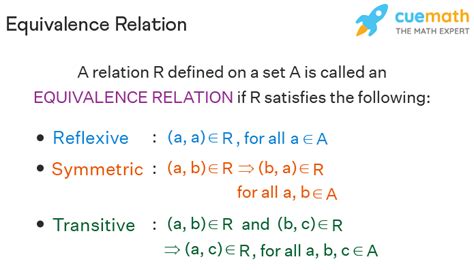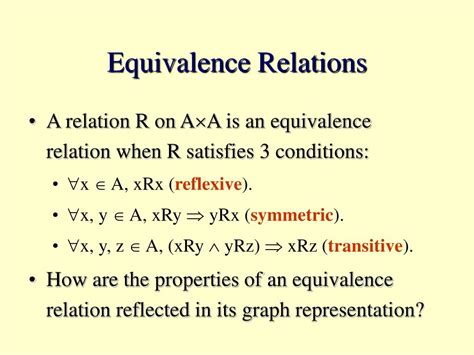Define An Equivalence Relation

An equivalence relation is a fundamental concept in mathematics, particularly in the fields of set theory and abstract algebra. It plays a crucial role in establishing relationships between elements of a set and provides a framework for understanding and analyzing the structure of mathematical objects.
In simple terms, an equivalence relation is a special type of binary relation that divides a set into subsets known as equivalence classes. These equivalence classes are collections of elements that are considered equivalent or interchangeable with each other under the given relation. By identifying these equivalence classes, we can simplify complex sets and gain deeper insights into their underlying structures.
Formal Definition and Properties

Formally, a relation R on a set A is considered an equivalence relation if it satisfies the following three properties:
- Reflexivity: For every element a in the set A, a R a must hold true. In other words, every element is related to itself under the equivalence relation.
- Symmetry: If a R b is true for elements a and b in set A, then b R a must also be true. This property ensures that the relation is symmetric, meaning that if a is related to b, then b is also related to a in the same way.
- Transitivity: For any three elements a, b, and c in set A, if a R b and b R c are both true, then a R c must also hold true. This transitivity property guarantees that the relation forms a chain, so if a is related to b and b is related to c, then a and c are also related.
These three properties, namely reflexivity, symmetry, and transitivity, are essential for defining an equivalence relation. They ensure that the relation is well-behaved and consistent, allowing us to establish meaningful connections between elements of a set.
Equivalence Classes and Partitions

When we define an equivalence relation on a set, it naturally partitions the set into equivalence classes. An equivalence class, denoted by [a], consists of all elements in the set that are related to each other under the given relation. In other words, [a] represents the collection of elements b such that a R b.
For example, consider the set of integers A = {1, 2, 3, 4, 5} and the equivalence relation R defined by a R b if a and b have the same parity (both odd or both even). The equivalence classes for this relation would be [1] = {1, 3, 5} and [2] = {2, 4}, as these are the subsets of A consisting of elements with the same parity.
The collection of all equivalence classes formed by an equivalence relation on a set A is called a partition of A. Each element of A belongs to exactly one equivalence class, and these classes collectively cover the entire set A. Partitions provide a way to break down a set into smaller, homogeneous subsets, making it easier to study and analyze the set's structure.
Applications and Examples
Equivalence relations have a wide range of applications in various areas of mathematics and beyond. Here are a few examples:
- Congruence Modulo n: In number theory, the relation a is congruent to b modulo n (denoted as a ≡ b (mod n)) is an equivalence relation. It partitions the integers into classes based on their remainders when divided by n, which is useful for studying arithmetic properties and modular arithmetic.
- Equivalence Classes in Group Theory: In abstract algebra, equivalence relations play a crucial role in defining quotient groups. By identifying elements that are equivalent under a group relation, we can form equivalence classes that represent the cosets of a subgroup, leading to a better understanding of group structures.
- Similarity Classes in Geometry: In geometry, equivalence relations are used to define similarity classes. For example, in Euclidean geometry, shapes that can be transformed into each other through translations, rotations, and reflections belong to the same similarity class.
- Equivalence Relations in Computer Science: In computer science, equivalence relations are utilized in various algorithms and data structures. For instance, in graph theory, isomorphism testing relies on identifying equivalence relations between graphs, and in database management, normalization processes often involve equivalence relations to simplify data structures.
Conclusion
Equivalence relations provide a powerful tool for simplifying complex sets and analyzing their structures. By partitioning sets into equivalence classes, we gain a deeper understanding of the relationships between elements and can apply this knowledge to various mathematical and real-world problems. From number theory to group theory and geometry, equivalence relations are an essential concept that underpins many areas of mathematics and its applications.
Can an equivalence relation have more than one equivalence class for a single element?
+No, an equivalence relation ensures that each element belongs to exactly one equivalence class. The reflexivity property guarantees that every element is related to itself, and thus, it cannot belong to multiple equivalence classes simultaneously.
Are all equivalence relations commutative?
+No, equivalence relations do not need to be commutative. Commutativity refers to the property where a and b are interchangeable in an operation, such as a + b = b + a. While symmetry ensures that a R b implies b R a, it does not imply commutativity in the traditional sense.
How do equivalence relations differ from other types of relations, such as partial orders or equivalence classes in group theory?
+Equivalence relations differ from partial orders in that they are not required to be antisymmetric (where a and b cannot be both related and not related) or transitive (where a and c are related if a is related to b and b is related to c). In group theory, equivalence classes are formed based on the group relation, which may have additional properties specific to the group structure.



